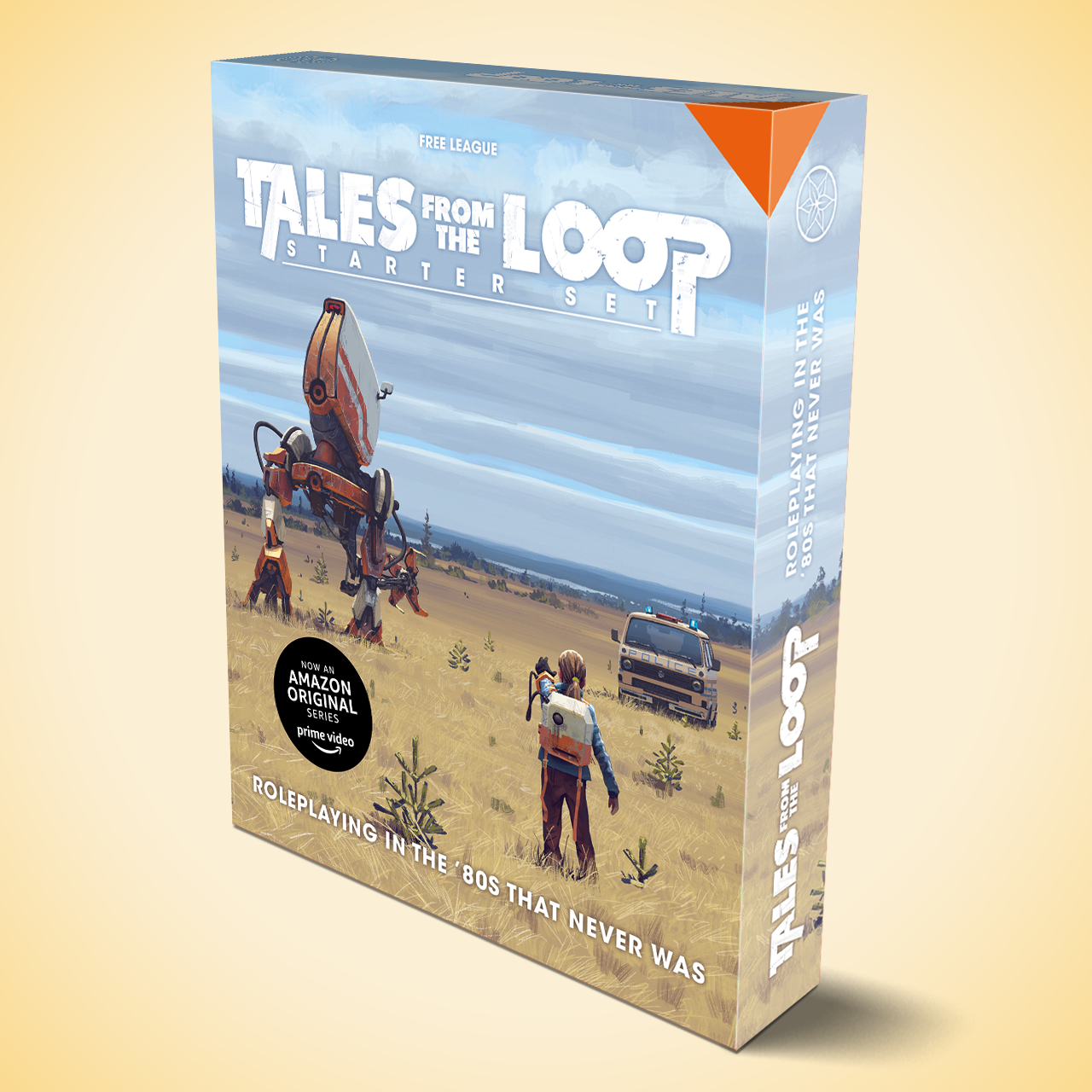Review copy provided by Free League Publishing
Free League Publishing delivers a lot of exceptional roleplaying experiences. The team has published the official ALIEN RPG, as well as Mutant: Year Zero, Forbidden Lands, Symbaroum, Coriolis, and several others.
But one IP has grown substantially over the last couple years—Tales From The Loop. It’s an exploration of an alternate 1980s that never was. Inspired by artist and author Simon Stålenhag, it’s a vision of Scandinavia where technology transformed ordinary life with extraordinary innovation, and the otherwise tranquil landscape is littered with things that you’d only see in science fiction.
When it launched in 2017, the RPG won five Gold ENnies, including Best Game and Product of the Year. From a roleplaying perspective, the game was a smash hit. Three years later, though, the universe is expanding, with an Amazon Prime Video television series that launched a few months ago and a new boxed Starter Set that released last month.
Starter sets and pre-made scenarios are becoming more popular in roleplaying games because it lowers the bar for entry into the tabletop adventures. With characters already created, a story already written, and simplified rules pulled from the core rulebook, these ready-to-play narratives ease newcomers into the world of RPGs and allow both the GM and the players to experience a shared story without a lot of upfront work.
The Tales from the Loop Starter Set comes with a condensed version of the rules that guide play in the RPG, as well as “The Recycled Boy,” a Mystery for the Kids to uncover over the course of one or two sessions. There are character sheets for up to five Kids, as well as a map, custom dice, and the story booklet for the GM.
STORY
The landscape was full of machines and scrap metal connected to the facility in one way or another. Always present on the horizon were the colossal cooling towers of the Bona Reactor, with their green obstruction lights. If you put your ear to the ground, you could hear the heartbeat of the Loop—the purring of the Gravitron, the central piece of engineering magic that was the focus of the Loop’s experiments.
The world in Tales from the Loop looks a lot different from ours. It’s set in the 1980s… that never was. This is a universe in which Stranger Things isn’t so strange. Where E.T. doesn’t have to phone anywhere because he’s already home. One in which the Predator could easily be prey, and many of the other ‘80s science fiction stories would fit right in.
Whether set in the Swedish Mälaren Islands or in Boulder City, Nevada, the game interrupts the dull, ordinary life of its citizens with some truly fantastical things. Scientific experiments, secret labs, wondrous technology, and more.
And the adults don’t appreciate the mysterious and they don’t investigate the strange. They have lost their sense of adventure and curiosity. And even when presented with the innovative world around the Loop, they prefer to continue on with life as simply as possible.
But the kids. They are willing to explore the unknown, confront the impossible, and investigate all the strange goings-on around the Loop. The RPG revolves around these children and the crazy events that transpire in their lives. Robots, time travel, exotic creatures, and everything else that can happen when anything is possible.
They just have to be sure not to miss school and to be home by dinner.
GAMEPLAY
The gameplay is very simple in Tales from the Loop. If you’ve had any experience with roleplaying games, then the mechanics of the RPG will be easy to pick up.
It’s a narrative-based game, with the players and the gamemaster working together to build a story with a beginning, middle, and end. The story is broken up into scenes, which allows the GM to skip boring parts of the day and night, and the players are able to jump from moment to moment for the most exciting experience possible.
Tales from the Loop is not as harsh or final as other RPG games, though. Characters cannot die. The Kids can be scared, upset, or suffer from several other conditions. But they never die. Which is different from other roleplaying systems, but it makes sense given the setting with young children between the age of 11 and 15.
There are six guiding principles that oversee gameplay in the RPG:
Your home town is full of fantastic things.
Everyday life is dull and unforgiving.
Adults are out of reach and out of touch.
Mysteries are dangerous but Kids will not die.
The game is played scene by scene.
The world is described collaboratively.
These are the tenets by which the group will abide. They’re straightforward and they help to keep the narrative on track. Scene-by-scene stories are woven by the interplay of roleplaying gamers and the GM—who makes sure everything is logical and appropriate for the Mystery, whether it's pre-fabricated by Free League Publishing or outlined by the GM.
Things that happen normally and actions that aren’t outside of everyday life can be just explained or narrated by the group, but anything that will require special talent or more expertise and effort in a given area must be attempted with a roll.
There are four base attributes—Body, Tech, Heart, and Mind—and these are further divided into connected skills that apply to most of the obstacles and Troubles that you will encounter in the game. Kids will excel in different areas, and it’s up to the players and the GM to decide how certain scenarios are approached.
Beyond that, there are other mechanics like Luck, Pride, Drive, and Items that influence gameplay, but the basic foundation of Tales from the Loop stems from the scene-based story, the cooperation of the players, the die rolls (with the successes or failures that follow), and the oversight of the GM.
It’s an exciting way to either return to life in the ‘80s for those that fondly remember the time or for curious gamers to explore a so richly-mined part of our popular culture and step into the shoes of Kids who grew up in that era.
While I don’t want to spoil any of the narrative that comes with the Starter Set, the Tales from the Loop RPG effectively creates an alternate reality that both awes the players who leap into an otherworldly experience and incites the curiosity of the group.
It’s like slipping into the TV when watching Stranger Things or sliding back into time through some of the beloved movies, television shows, and pop culture remnants that revealed the optimism and mystery of the 1980s.
For the eager roleplayer or the anxious newcomer, it’s a fun way to sit at the table and build a story together.
VISUALS
The art of Simon Stålenhag is truly wonderful. It’s at once familiar and alien. Peaceful landscapes and tranquil settings are marred by strange images. Creatures, machines, and structures that don’t match the time. Or don’t belong. At least not in our world.
It’s easy to be transported into another reality with the art of Tales from the Loop. And that’s part of its draw. Part of its charm.
You can stare at the images and see some new detail that you missed before. The sense of wonder that you get is similar to how you would feel as a child, taking in the marvels for the first time.
The gameplay is enhanced by the art because the visual splendor of Simon Stålenhag’s work helps to anchor the players in the world. Their imagination is sparked by his creativity.
REPLAYABILITY
This is the only downside of starter sets and pre-fabricated stories. They can only really be played once. If the GM ever switches out players, it can be revisited for a new experience, but these are mainly designed for one or two sessions.
An upside is that players can get an idea of whether or not they’ll like the RPG before buying a bigger bundle or the core rulebook.
I consider the cost akin to buying movie tickets. You’re paying for one experience and once it’s finished the story has been told. The value makes sense for me because it eases players into an RPG that they might not have considered otherwise. And it can give ideas and guidance for later gameplay with other Mysteries and the core rules of the RPG.
But that line of reasoning isn’t for everyone, and the replay value of the Starter Set might not be worth it for some players.
It’s something to consider.
WHAT IT COULD HAVE DONE BETTER
Roleplaying is not for everyone. And roleplaying as kids is not for everyone who likes roleplaying. So you have to consider the audience for a game like this.
I wasn’t alive in the ‘80s. So the nostalgia-pull isn’t there for me. I like science fiction, though, so that helps. And Free League Publishing makes solid RPG experiences, so I’ve enjoyed that. And I also like roleplaying.
All of that means that I’m intrigued by the sci-fi setting and enamored with the art of Tales from the Loop, but the time period is not something that inexorably pulls me in. And playing as a teenager is not something that naturally appeals to me. I’m not opposed to new things or adventurous opportunities, so I don’t feel the need to roleplay as a youth who possesses characteristics I’ve since lost.
But those are less complaints about the design of the game or weaknesses in Tales from the Loop and more reasons why it doesn’t connect as strongly for me. Why it may not connect as strongly for other gamers as well.
It will be up to you to decide whether it works for you.
As for the gameplay and the world, Free League Publishing and the writers have done a convincing job of bringing this new reality to life.
VERDICT
Tales from the Loop is a captivating world, rich with mysteries to solve, curiosities to explore, and relationships to untangle. Life is boring, and Kids are there to spice things up by probing into all the dark and wondrous corners of the land. Sometimes, Trouble will rear its ugly head, but Kids are used to Trouble—getting in it and out of it.
If you’re a fan of the 1980s, and if your imagination bubbled with the dreamy world of robots, secrets, and the unexpected, then this is the roleplaying experience for you.
The Starter Set from Free League Publishing has everything you need to get going, and the art from Simon Stålenhag deserves to be applauded.
Enjoy all of the ways to start playing from the Fria Ligan store.

























